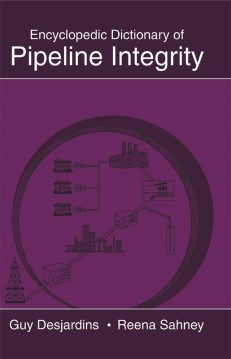Description
From the National Transportation Safety Board Safety Study
Integrity Management of Gas Transmission Pipelines in High Consequence Areas,
January 27, 2015:“The study did find that IM programs… require expert knowledge and integration of multiple technical disciplines including… probability and statistics, and risk management…. The study found that aspects of the operators’ threat identification and risk assessment processes require improvement.”
Available as:
Print Book
E-book
The optimum management of risks emerges from the best understanding of risks. Risk understanding is now available to all, via efficient and intuitive risk assessment. This book presents the definitive approach to assessing risks from pipelines?an approach that overcomes the limitations of previous methodologies.
As the definitive approach, the methodology must:
- Provide clarity – generating immediately useful information to decision-makers
- Be comprehensive and complete
- Capture and integrate real world processes
- Dispel myths arising from risk assessment past practice
- Remove unnecessary complexity that interferes with understanding risk
- Be cost-effective to create, apply, and manage.
As with the author’s previous works, the recommended methodology detailed here is a practical, easy-to-apply approach to measuring risks associated with operating any type of pipeline in any environment. Risk assessment need not be a complex academic exercise. It should be a straightforward practice, used by ? and useful to ? any and all stakeholders in a pipeline’s operation.
Some specific features of the definitive approach include:
- The three critical determinants of failure probability?exposure, mitigation, resistance.
- Using inspection information directly, intuitively, and efficiently in a risk assessment.
- Measuring damage potential separately from failure potential.
- Automatic and intuitive incorporation of interacting threats?weaknesses overlapping failure mechanisms.
- The role of time-to-failure estimation in modeling corrosion and cracking.
- Using hazard zones to understand potential consequence scenarios.
- Representing all possible consequence scenarios with a manageable set.
- The best use?not the most common use?of historical incident statistics
- The essential role of the risk profile?proper risk management cannot occur without it.
- Conservatism?both P50 and P90+ risk assessments are needed.
- Making the risk assessment readily expandable?it should ‘get smarter’ as new knowledge becomes available.
Herein lies essential guidance for keeping pipelines safe: Improving risk knowledge, leading to superior risk management, leading to safer pipelines.
Click here to review the Table of Contents.
W. Kent Muhlbauer
Mr. Muhlbauer is an internationally recognized authority on pipeline risk management. In this field, he is an author, lecturer, consultant, and software developer. Techniques developed by Mr. Muhlbauer are in use by the largest pipeline operators in the U.S. and in pipeline operations in many other countries. Mr. Muhlbauer is an advisor to private industry, government agencies, and academia, as well as a frequently invited speaker at industry conferences worldwide. Mr. Muhlbauer also has an extensive background in pipeline design, operations, and maintenance, having held multiple technical and management positions in a pipeline operating company for many years prior to founding WKM Consultancy, LLC, a company providing specialized consulting on pipeline issues.
If you are purchasing an eBook, once your eBook order is processed, you will receive an email containing a download link. You will be allowed installation of the eBook on two separate computers.





